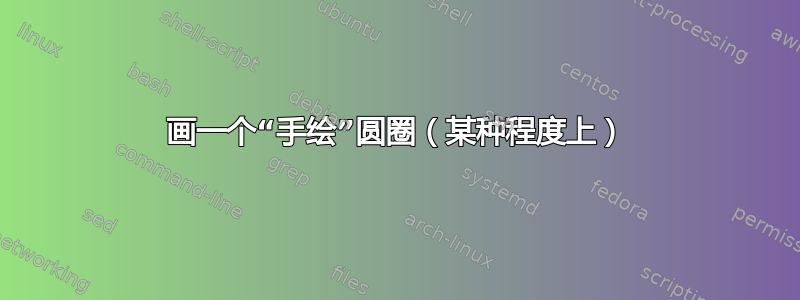
我想要一种更好的方法来绘制近似手绘圆圈的东西tikz:
\documentclass{article}
\pagestyle{empty}
\usepackage{tikz}
\usetikzlibrary{calc}
\begin{document}
\begin{tikzpicture}
\coordinate (A) at (0,0);
\coordinate (C) at (2in, 0);
\coordinate (B) at ($(C)!1in!-90:(A)$);
\draw (A) -- (C) -- (B) -- cycle;
\coordinate (A/u) at ($(A) + (30:1em)$);
\coordinate (A/d) at ($(A) + (-10:1em)$);
\coordinate (A/x) at ($(A) + (120:2em)$);
\coordinate (A/y) at ($(A) + (-120:2em)$);
\draw[line width=1pt] (A/d) .. controls (A/x) and (A/y) .. (A/u);
\end{tikzpicture}
\end{document}

我知道模拟手绘线条。虽然摇摆的效果很好,但我还是想得到一些接近圆形但两端不太相接的东西。
答案1
在...的帮助下模拟手绘线条,似乎可以得到更好的结果(红色的对于这种特殊的应用,使用方形和打击乐的decoration=penciline,以及使用 Alain Matthes 的 ,圆形效果会更好\freedraw:

代码:
\documentclass{article}
\pagestyle{empty}
\usepackage{tikz}
\usetikzlibrary{calc,decorations.pathmorphing,patterns,shapes}
%% https://tex.stackexchange.com/questions/39296/simulating-hand-drawn-lines: percusse
\pgfdeclaredecoration{penciline}{initial}{
\state{initial}[width=+\pgfdecoratedinputsegmentremainingdistance,auto corner on length=1mm,]{
\pgfpathcurveto%
{% From
\pgfqpoint{\pgfdecoratedinputsegmentremainingdistance}
{\pgfdecorationsegmentamplitude}
}
{% Control 1
\pgfmathrand
\pgfpointadd{\pgfqpoint{\pgfdecoratedinputsegmentremainingdistance}{0pt}}
{\pgfqpoint{-\pgfdecorationsegmentaspect\pgfdecoratedinputsegmentremainingdistance}%
{\pgfmathresult\pgfdecorationsegmentamplitude}
}
}
{%TO
\pgfpointadd{\pgfpointdecoratedinputsegmentlast}{\pgfpoint{0.5pt}{1.5pt}}
}
}
\state{final}{}
}
%% https://tex.stackexchange.com/questions/39296/simulating-hand-drawn-lines: Alain Matthes
\pgfdeclaredecoration{free hand}{start}
{
\state{start}[width = +0pt,
next state=step,
persistent precomputation = \pgfdecoratepathhascornerstrue]{}
\state{step}[auto end on length = 3pt,
auto corner on length = 3pt,
width=+2pt]
{
\pgfpathlineto{
\pgfpointadd
{\pgfpoint{2pt}{0pt}}
{\pgfpoint{rand*0.15pt}{rand*0.15pt}}
}
}
\state{final}
{}
}
\tikzset{free hand/.style={
decorate,
decoration={free hand}
}
}
\def\freedraw#1;{\draw[free hand] #1;}
\begin{document}
\begin{tikzpicture}
\coordinate (A) at (0,0);
\coordinate (C) at (1in, 0);
\coordinate (B) at ($(C)!1in!-90:(A)$);
\draw (A) -- (C) -- (B) -- cycle;
\coordinate (A/u) at ($(A) + (30:1em)$);
\coordinate (A/d) at ($(A) + (-10:1em)$);
\coordinate (A/x) at ($(A) + (120:2em)$);
\coordinate (A/y) at ($(A) + (-120:2em)$);
\begin{scope}[decoration=penciline]
\draw[thick, fill=blue!25, fill opacity=.25, draw=red, decorate] ($(A)+(-0.1cm,-0.1cm)$) rectangle (0.1cm,0.2cm);
\draw[thick, draw=brown, radius=0.1cm, decorate] (B) circle (0.15cm);
\draw[thick, draw=blue, x radius=0.15cm, y radius=0.19cm, rotate=30, shape=circle, decorate,] (C) circle {};
\node [above left] at (B) {decoration=penciline};
\end{scope}
\end{tikzpicture}
\hspace*{0.3cm}
\begin{tikzpicture}
\coordinate (A) at (0,0);
\coordinate (C) at (1in, 0);
\coordinate (B) at ($(C)!1in!-90:(A)$);
\draw (A) -- (C) -- (B) -- cycle;
\coordinate (A/u) at ($(A) + (30:1em)$);
\coordinate (A/d) at ($(A) + (-10:1em)$);
\coordinate (A/x) at ($(A) + (120:2em)$);
\coordinate (A/y) at ($(A) + (-120:2em)$);
\freedraw[thick, draw=blue] ($(A)+(-0.1cm,-0.1cm)$) rectangle (0.15cm,0.2cm);
\freedraw[thick, fill=blue!25, fill opacity=.25, draw=red] (B) circle [radius=0.2cm];
\freedraw[thick, fill=blue!25, fill opacity=.25, draw=red, x radius=0.15cm, y radius=0.19cm, rotate=30, shape=circle,] (C) circle {};
\node [above left] at (B) {\textbackslash freedraw};
\end{tikzpicture}
\end{document}
答案2
我不知道如何驾驶tikz,所以如果语法不规范,请原谅。但我所做的是采取\mathcal{O}并以用户可定义的方式拉伸和旋转它:
\documentclass{article}
\pagestyle{empty}
\usepackage{tikz}
\usetikzlibrary{calc}
\newcommand\handoh[3][0]{%
\scalebox{#2}[#3]{\raisebox{1pt}{\kern3pt\rotatebox{#1}{%
\kern-4.5pt\raisebox{-2pt}{$\mathcal{O}$}\kern-4pt}}\kern2pt}%
}
\begin{document}
\begin{tikzpicture}
\coordinate (A) at (0,0);
\coordinate (C) at (2in, 0);
\coordinate (B) at ($(C)!1in!-90:(A)$);
\draw (A) -- (C) -- (B) -- cycle;
\coordinate (A/u) at ($(A) + (30:1em)$);
\coordinate (A/d) at ($(A) + (-10:1em)$);
\coordinate (A/x) at ($(A) + (120:2em)$);
\coordinate (A/y) at ($(A) + (-120:2em)$);
\node (D) [label=left:{\textbackslash handoh[160]\{2.5\}\{3\}}]
at (A) {\handoh[160]{2.5}{3}};
\node (E) [label=left:{\textbackslash handoh[45]\{1.3\}\{1.7\}}]
at (B) {\handoh[45]{1.3}{1.7}};
\node (F) [label=below:{\textbackslash handoh[-70]\{2.5\}\{1.5\}}]
at (C) {\handoh[-70]{2.5}{1.5}};
\end{tikzpicture}
\end{document}

答案3
如果圆的另一侧没有另一个中点,则很难获得您想要的真正圆形。此 MWE 添加了另一个中点,并稍微调整了控制点,以获得略带圆形、略带不规则的形状。
事实上,虽然“摇摆”效果对于较直的线段来说很好,但大多数时候我发现小圆圈是相当平滑的线条,通常是椭圆形的......
梅威瑟:
\documentclass{article}
\pagestyle{empty}
\usepackage{tikz}
\usetikzlibrary{calc}
\begin{document}
\begin{tikzpicture}
\coordinate (A) at (0,0);
\coordinate (C) at (2in, 0);
\coordinate (B) at ($(C)!1in!-90:(A)$);
\draw (A) -- (C) -- (B) -- cycle;
\coordinate (A/u) at ($(A) + (40:.8em)$);
\coordinate (A/d) at ($(A) + (-20:1.1em)$);
\coordinate (A/l) at ($(A) + (180:.7em)$);
\coordinate (A/x) at ($(A) + (50:1em)$);
\coordinate (A/y) at ($(A) + (120:1.2em)$);
\coordinate (A/v) at ($(A) + (-120:1.6em)$);
\coordinate (A/w) at ($(A) + (-30:1.8em)$);
\draw[line width=1pt] (A/d) .. controls (A/x) and (A/y) .. (A/l) .. controls (A/v) and (A/w) .. (A/u);
\end{tikzpicture}
\end{document}
给出:



